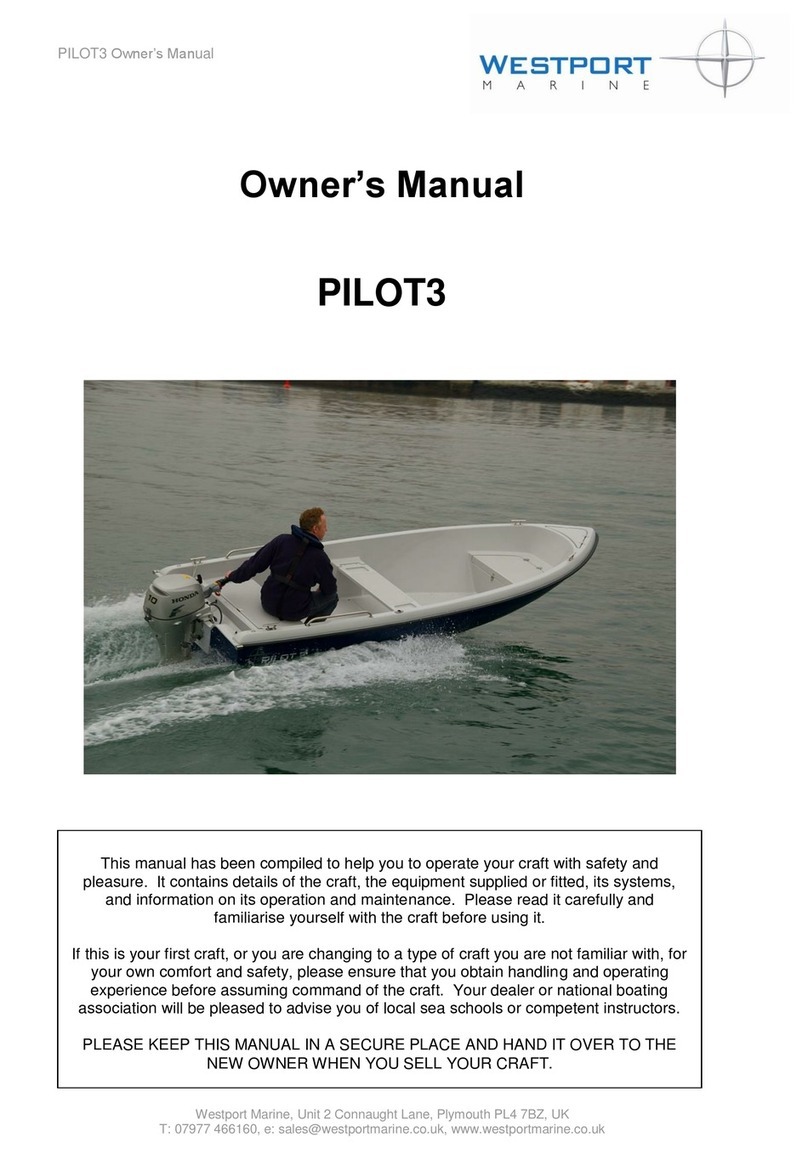
PILOT4 Owner’s Manual
Page 9 of 12
flushing the system with a hose prior to launching the boat. If the problem persists then the
system should be examined by an experience marine engineer.
Mooring, Anchoring & Towing (W)
During mooring and anchoring operations access to the fore deck with the cuddy fitted is via
the foredeck access hatch in the cuddy top. By standing through the hatch, with feet on the
forward non-slip seat top, it is possible to reach the foredeck cleat and fairleads in safety. At
no time shall any person sit or stand on the foredeck.
Prior to launching, mooring or anchoring it is recommended that all lines & fenders be
prepared and attached to the boat, as required, prior and in good time to the operation to be
undertaken. Always plan ahead and assess any potential difficulty, ensuring that your crew
are fully aware of your intentions and their responsibilities.
While anchoring it may be easier to launch and recover the anchor from the main working
deck with the aid of a boat hook. New owners should practice both methods ensuring that
they are competent of anchoring in an emergency situation, especially in deteriorating
conditions.
It is the owner’s/operators responsibility to ensure that mooring lines, tow lines and anchor,
chain & line are adequate for the vessel’s intended use. The breaking strength of all
lines/chains shall in general not exceed 10.25KN (80% of the breaking strength of the deck
cleats).
Owners should consider and practice the making fast of a tow line, in a manner that shall
allow the tow to be release while under load, ensuring that they are fully prepared in the
event of an emergency.
Always tow or be towed at a slow speed. Never exceed the hull speed of a displacement
craft when being towed.
Launching & Trailering (W)
Ensure that the centre rollers of the trailer bear the keel of your boat in a correct way, and
adjust the lateral bearing to avoid any movement. Do not forget to fasten the tie down
straps. Do not load the craft when trailering.
New owners/operators should seek instruction/guidance on launching and recovery from the
dealer or local sea school/powerboat instructor. Do not attempt launching/recovery without
adequate instruction.
Lifting (D)
Adjust the location and length of lifting strops to ensure the craft is horizontal when being
lifted. Provide protection between the strops and the craft. Do not use warp to lift the craft.
Do not load or stand under the craft while being lifted.
Removable Cuddy (D)
Always use two people when removing or fitting the cuddy. The cuddy locates on a raised
moulding around the forward seating area and is held in place with four safety catches. The
safety catches have a spring release mechanism to prevent the catch opening accidentally.
In addition each catch is supplied with a retaining clip which must be removed to enable the
catch to be release. It is the owner’s/operators responsibility to regularly inspect and maintain
each safety catch and replace any parts as necessary.
DANGER: DO NOT OPERATE OR TOW THE CRAFT WITHOUT FIRST CHECKING THAT
ALL CATCHES ARE SECURLY FASTENED AND HAVE THEIR RETAINING CLIPS
FITTED. REGUARLY CHECK EACH SAFETY CATCH WHILE OPERATING THE CRAFT.






























